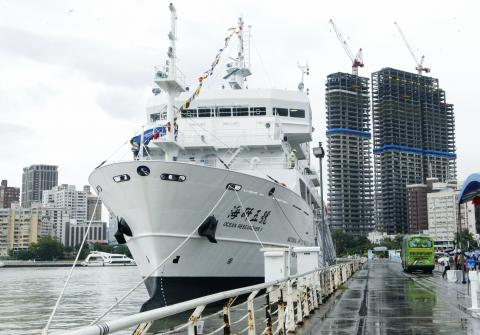Ocean Researcher V, the largest ocean research vessel designed and built in Taiwan, was officially handed over to the National Applied Research Laboratories (NARL) yesterday.
The 2,700 tonne ocean research vessel, measuring 72.6m in length and 15.4m in width, has a boarding capacity of 18 crew members and 30 scientists and is now docked at Greater Kaohsiung’s Singda Harbor.
The vessel was funded by the National Science Council (NSC), which commissioned the task to the NARL’s Taiwan Ocean Research Institute (TORI).

Photo: CNA
TORI’s Deep Ocean Exploration Division manager and associate researcher Yang Yih (楊益) said the Ocean Researcher V differs from the three existing ocean research vessels because of its expanded tonnage, which gives it enough resistance to cope with strong waves caused by the northeast monsoons in the winters and allows it to gather research data that in the past was difficult to collect.
Moreover, the vessel’s maximum endurance is expanded to 50 days and a maximum range of 13,000 nautical miles (24,076km) for each single expedition, Yang said, adding that its core mission is not limited to fundamental ocean science research and that it can also perform the government’s ocean energy exploration assignments.
TORI’s Nearshore Observation and Modeling Division and Marine Exploration Technology Division manager and researcher Yang Wen-Chang (楊文昌) said the vessel is scheduled to make research expeditions for a total 250 days a year. Of these 250 days, 100 days would be allotted to academic science research projects funded by the NSC, while the remaining 150 days would go to the NARL’s research projects, governmental assignments or business sector research trips.
TORI director-general Kao Chia-chuen (高家俊) said the two special features of the Ocean Researcher V are its propelling force — which relies on electricity, allowing it to move slowly yet quietly, traits necessary for conducting precise detection operations — and its dynamic positioning system — which allows it to remain steadily at a single spot at sea, undisturbed by strong winds or waves.
In addition to its observational capabilities, such as high-resolution imaging of the sea bed, the vessel can also collect samples deep under the sea’s surface with the use of a remotely operated vehicle (ROV), which can go as deep as 3,000m, Yang Yih said, adding the ROV is planned to be used in research projects exploring sea-floor gas hydrate near southern Taiwan.
Lu Pei-ling (呂佩玲), deputy director of the Central Weather Bureau’s seismology center, said TORI has also agreed to use the new vessel to assist the bureau with the maintenance of submarine cables off the coast of eastern Taiwan, which would improve the precision of earthquake forecasts in Taiwan.
At present, NT$1.82 billion (US$61 million) has been spent on the vessel, while an additional NT$600 million to NT$700 million is to be spent on the acquisition of more research equipment, Kao said.
The vessel is scheduled to embark on its first expedition in January next year, while adjustments to the existing equipment, purchase of new equipment, as well as further training for the crew members, would continue in the coming months, he added.

SHIPS, TRAINS AND AUTOMOBILES: The ministry has announced changes to varied transportation industries taking effect soon, with a number of effects for passengers Beginning next month, the post office is canceling signature upon delivery and written inquiry services for international registered small packets in accordance with the new policy of the Universal Postal Union, the Ministry of Transportation and Communications said yesterday. The new policy does not apply to packets that are to be delivered to China, the ministry said. Senders of international registered small packets would receive a NT$10 rebate on postage if the packets are sent from Jan. 1 to March 31, it added. The ministry said that three other policies are also scheduled to take effect next month. International cruise ship operators

HORROR STORIES: One victim recounted not realizing they had been stabbed and seeing people bleeding, while another recalled breaking down in tears after fleeing A man on Friday died after he tried to fight the knife-wielding suspect who went on a stabbing spree near two of Taipei’s busiest metro stations, Taipei Mayor Chiang Wan-an (蔣萬安) said. The 57-year-old man, identified by his family name, Yu (余), encountered the suspect at Exit M7 of Taipei Main Station and immediately tried to stop him, but was fatally wounded and later died, Chiang said, calling the incident “heartbreaking.” Yu’s family would receive at least NT$5 million (US$158,584) in compensation through the Taipei Rapid Transit Corp’s (TRTC) insurance coverage, he said after convening an emergency security response meeting yesterday morning. National

PLANNED: The suspect visited the crime scene before the killings, seeking information on how to access the roof, and had extensively researched a 2014 stabbing incident The suspect in a stabbing attack that killed three people and injured 11 in Taipei on Friday had planned the assault and set fires at other locations earlier in the day, law enforcement officials said yesterday. National Police Agency (NPA) Director-General Chang Jung-hsin (張榮興) said the suspect, a 27-year-old man named Chang Wen (張文), began the attacks at 3:40pm, first setting off smoke bombs on a road, damaging cars and motorbikes. Earlier, Chang Wen set fire to a rental room where he was staying on Gongyuan Road in Zhongzheng District (中正), Chang Jung-hsin said. The suspect later threw smoke grenades near two exits

The Forestry and Nature Conservation Agency yesterday launched a gift box to market honey “certified by a Formosan black bear” in appreciation of a beekeeper’s amicable interaction with a honey-thieving bear. Beekeeper Chih Ming-chen (池明鎮) in January inspected his bee farm in Hualien County’s Jhuosi Township (卓溪) and found that more than 20 beehives had been destroyed and many hives were eaten, with bear droppings and paw prints near the destroyed hives, the agency said. Chih returned to the farm to move the remaining beehives away that evening when he encountered a Formosan black bear only 20m away, the agency said. The bear